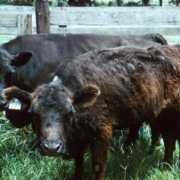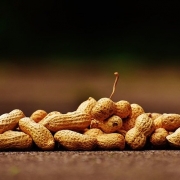Types of Fungal Diseases in Canines
Most agents of parasitic fungi exist as an organism in soil, decaying vegetation and feces, and on decaying animal matter and tissues. The soil and the air is the primary source of most infections, which can be acquired by ingestion, inhalation, or even through the skin. Those fungi capable of producing infection in hosts, such as histoplasmosis, coccidioidomycosis, and blastomycosis are regarded as primary systemic mycoses. Opportunistic fungi, such as aspergillosis, and cryptococcosis, usually require a host that is debilitated, or immune-suppressed, to establish infection, but stronger strains have been doing just the opposite. Clinical diagnosis of fungal infections can only be reached by both the culture and microscopic identification of the organism. Serology may also be used as a diagnostic tool for some fungal disease.
Aspergillosis
Aspergillosis is a fungal infection seen in mostly young dogs–in particular, those breeds with a long nose. The fungus affects the nasal chambers but lesions can occur in several organs, including the eye. More and more cases are being reported due to housing problems with toxigenic moulds. It first begins in the posterior region of the nasal cavity with a nasal discharge that may last for months before becoming purulent and bloody. Nasal pain, sneezing and lethargy accompany these symptoms, and as the disease progresses the fungus may destroy and replace the spongy nasal passages with masses of fungi growth. If not diagnosed and treated, the fungi continue to grow into the cranium and the soft tissue around the eye. Since diagnosis of the disease from culture is not always easy, microscopic evaluations of the fungus from areas of the nasal cavities and membranes is also needed for positive identification. Radiographs may show tissue destruction since frontal sinus osteomyelitis will be apparent. Treatment of aspergillosis with systemic drugs and sometimes surgical scraping of the nasal passages is involved, expensive, and of long duration. Iodine flushes have been used with some success followed by systemically administered drags such as ketoconazole, thiabendazole, or itraconazole.
Cryptococcosis
Cryptococcosis is another systemic fungal disease that affects the respiratory tract, eyes, skin, and central nervous system of dogs. The fungus exists in the environment and in tissues in a yeast form. The fungus is found in soil and fowl dropping, especially pigeons. Transmission is by the inhalation of the spores or the contamination of open wounds. Dogs, especially young dogs under one year, tend to have the infection quite severely, with the infection first showing up as lesions on the lungs, facial regions, legs, and the cerebral cavities. It rapidly spreads to their central nervous system and eyes. Organs most usually involved include the kidneys, lymph nodes, liver, spleen, thyroid, adrenals, pancreas, heart valves, tonsils, GI tract, and muscles. If the brain is involved the dog will show signs of circling, staggering, behavior changes, accompanied by sneezing, coughing, nasal and eye discharge, and in some cases, blindness. There is little success in treatment when the infection has spread to this point.
Cutaneous lesions which have not disseminated can be removed surgically, and the dog treated with amphotericin, given IV three times a week until evidence of success is shown. The lesions show up as slimy, mucoid, and ulcerating, accompanied by tissue swelling. Diagnosis of the disease can be confirmed by microscopic examination of the fluid. Ketoconazole, itraconazole or fluconazole have also been successful as treatment.
Histoplasmosis
Canine histoplasmosis is a non-contagious systemic fungus that grows in the soil in tropical and subtropical regions, especially endemic in the Mississippi and Ohio River valleys and the Appalachian Mountain range. Bird, chicken and bat manure provide a rich environment for the fungus, but other origins have recently been reported.
Some forms of the disease are mild and self-limiting, or involve only the lungs and lymph nodes of the chest. The organisms enter the body through the respiratory tract and become disseminated throughout the body, with the signs of the disease varying, depending on the various organs involved. Many dogs have a long course of weight loss due to severe diarrhea, characterized by fresh blood, straining, and mucous, high fever, and anemia. The dog may have a chronic cough and show respiratory difficulty due to obstructions and enlargements of the bronchial lymph nodes. Dissemination may involve ocular disease, weeping ulcerated nodules on the skin, ulcerated intestinal walls, enlargement of the liver and spleen, accompanied by depression, anorexia, lameness and ocular disease.
Presence of the fungus is determined by rectal scrapings in dogs with diarrhea or needle aspirations of the lymph nodes and lungs. The more acute and widespread the infection is, the less promising is any drug therapy, but with early diagnosis, antifungal drug therapy with ketoconazole may improve the outlook. Since Histoplasmosis is primarily a chronic diarrhea disease, the illness can progress so rapidly that not even the antifungal drug can help if treatment and diagnosis is delayed… For severe cases, concurrent treatment with amphotericin has been used with success.
Hypoallergenic diets must contain ingredients not previously encountered by the patient and all other potential sources of offending substances should be excluded, including rawhide chews, table scraps, vitamin and mineral supplements. Response to the hypoallergenic diet rarely occurs within the first week. If the dog’s skin condition improves by the twenty-first day, diet is probably at fault, and the dog will be put back on his original diet. If the animal’s itchiness increases, there is no doubt about what the problem is. In this case you will need to find a diet that is both nutritionally sound and free of the offending substances.
Blastomycosis
North American Blastomycosis is a fungal disease that is most usually found in the Mississippi River area and around the Great Lakes, along with areas in the South and Southwest where soil is moist, acidic, and rich in decaying vegetation. Rain, dew, or fog may play a critical role in aerosolizing the fungus. The primary entry is the respiratory tract by way of inhalation of spores from sites of fungal growth. For some reason the dogs most affected are usually young intact males, two to four years of age, with hunting breeds most likely to pick up the fungus than other dogs.
The disease is characterized by lesions in various tissues with organ involvement. Lesions and nodules consist of numerous, variable sized, irregular pus-filled granulomas that multiply and ulcerate through the skin as cutaneous pustules covered with yellow scabs. The bronchial lymph nodes enlarge and the dog will show signs of a fever and respiratory problems including coughing, and a nasal discharge. Dry, harsh lung sounds from lung lesions are commonly found. The infection may also involve the urinary tract, with blood in the urine, and difficult urination. If the disease spreads to the eyes and growths develop in the eyeballs, glaucoma, retinal detachment, and blindness can result. Weight loss is evident, accompanied by anorexia, and lameness from nodular lesions on bones.
Blastomycosis should be considered when a dog has both respiratory problems and draining nodules on the skin, along with extreme weight loss. Diagnosis can be made from radiographic findings in the lungs or from aspirated samples from lesions. This fungus does not respond well to treatment unless caught early, and the lesions removed surgically. The prognosis is best for dogs without lung disease or even with only a moderate lung disease. With the use of Ketoconazole and Amphotericin B, some symptoms can be reduced without a chance of relapse, but the treatment will require extensive veterinarian management.
Valley Fever
Valley Fever is a fungal disease found mostly in the dry areas of the Southwestern U.S., and northern Mexico. Dogs are most commonly affected, although many warm-blooded animals can contact it. It is not spread from one animal to another; it is not highly contagious; and can not spread from animal to man. Most dogs develop an immunity to it and never show outward signs of illness unless stressed with a lowered immune system.
Infection occurs by the dog inhaling spores from the soil. If infection happens, the inhaled spores burst in the lungs and start growing, usually in the lymph nodes. If the immune system does not kill the fungal organism here, they spread to many parts of the body, involving bone and eye tissue. Hunting dogs are particularly at risk of being exposed to the fungal spores, but even indoor dogs have a chance of exposure following a dust storm when billions of spores become airborne. A few years ago after a severe earthquake in the Los Angeles area disturbed dust, sand, and old buildings, several dogs were reported as having contacted the disease. However, the months of greatest exposure to the spores are May through August, when the fungi stop growing and produce spores to survive the dry, hot summer.
Most diagnosis of Valley Fever is based on a history of travel in prevalent areas, clinical signs, and laboratory testing. Clinical signs include a chronic, dry, persistent cough, breathing problems, depression, fever, decreased appetite, lethargy, weight loss, and in some cases, blindness. The lymph nodes may be swollen and enlarged along with extreme pain and lameness as the disease involves the bones or spinal column, and enlarged joints. Since it takes several months for these signs to become apparent, diagnosis is often delayed until the disease has progressed to the point where the dog is very ill. A blood test can confirm Valley Fever and treatment started, with the drug of choice being Ketoconazole, given twice a day. This medication is usually tolerated if given with food. Continuous use is necessary for at least six months before major results can be seen. Most dogs do respond to treatment and go on to live a healthy life, if the owner can handle the expensive medications and treatments.
This site contains copyrighted material the use of which has not always been specifically authorized by the copyright owner. We are making such material available in our efforts to advance understanding of environmental, political, human rights, economic, democracy, scientific, and social justice issues, etc. We believe this constitutes a ‘fair use’ of any such copyrighted material as provided for in section 107 of the US Copyright Law. In accordance with Title 17 U.S.C. Section 107, the material on this site is distributed without profit to those who have expressed a prior interest in receiving the included information for research and educational purposes. For more information go to: http://www.law.cornell.edu/uscode/17/107.shtml. If you wish to use copyrighted material from this site for purposes of your own that go beyond ‘fair use’, you must obtain permission from the copyright owner.

 copy;Photo borrowed from petmd.com
copy;Photo borrowed from petmd.com

 Image by
Image by 



